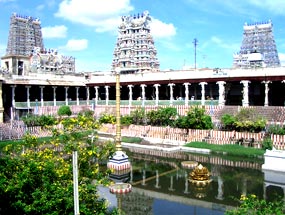Meenakshi Amman Temple of Madurai is devoted to
Lord Shiva & Goddess Parvati. Explore Sri Minakshi Temple of
Madurai, India.
Meenakshi Temple

Location: Madurai, Tamil Nadu
Founded In: 17th century
Dedicated To: Lord Shiva and Goddess Parvati
Meenakshi Amman Temple, also known as the Meenakshi Sundareswarar
Temple, is situated in the holy city of Madurai. One of the most visited
pilgrimages of Tamil Nadu, the temple is devoted to Lord Shiva (in the
form of Sundareswarar or the Beautiful Lord) and his consort, Goddess
Parvati (in the form of Meenakshi or the Fish-eyed Goddess). There are
very interesting legends surrounding the establishment of the Sri
Meenakshi Temple of India. It is said that Lord Shiva appeared in the
city of Madurai, in the form of Sundareswarar.
He came with His divine group of followers, with the purpose of
marrying Pandya King Malayadwaja Pandya's daughter, Meenakshi, believed
to be an incarnation of Goddess Parvati. It is because of this reason
that the Minakshi Amman Temple was established in the Madurai city of
Tamil Nadu. This temple counts amongst the four most sacred abodes of
Goddess Parvati in India. The second legend goes that Indra, the God of
heaven, found Shiva's idol, in the form of the lingam, in Madurai and
went on to build the Meenakshi Temple.
Even today, during festive processions, a model of Indra's vehicle
accompanies the idol of the deity. The temple is known throughout the
world for its breathtaking architecture and stands adorned with 12
magnificently sculptured and painted gopurams (towers). Though the
temple has been mentioned in Tamil literature since antiquity, its
present structure is believed to have been built in the early 17th
century. The history as well as the time of construction of the original
Meenakshi Amman Temple is not known.
It is said that the temple was pillaged by Malik Kafur, a Muslim
invader, in the year 1310. Almost all the ancient features and elements
of the temple were destroyed at that time. Arya Natha Mudaliyar, the
Prime Minister of the first Nayak of Madurai, was the person responsible
behind the reconstruction and restoration of the Meenakshi Sundareswarar
Temple. The period of 1623 to 1659 saw valuable contribution being made
to it by Thirumalai Nayak. He also got the Vasantha Mandapa constructed.
The sanctum sanctorum of the temple is more than 3500 years old, while
the outer walls were made about 1500-2000 years back. The entire temple
complex spreads over an area that measures about 45 acres. The tallest
tower surrounding the temple is the Southern tower, which rises to a
height of over 170 feet. The shrine of Lord Shiva is situated in the
heart of the complex and also houses a remarkable sculpture of Nataraja,
the dancing form of Shiva. Numerous other structures also make up the
complex.
Meenakshi Nayakkar Mandapam
Meenakshi Nayakkar Mandapam is a huge hall, adjoining Ashta Shakthi
Mandapam. It comprises of 110 pillars, which are adorned with the
figures of a peculiar animal called Yalli, with the body of a lion and
the head of an elephant.
Potramaraikulam (Golden Lotus Tank)
Potramaraikulam is a huge tank, where devotees take bath in the holy
water. The area surrounding the temple used to serve as the meeting
place of Tamil Sangam, the ancient academy of poets. The works of its
members were judged by throwing them in the water. The ones that did not
sink in the tank were considered worthy of attention. A pillared
corridor surrounds the holy tank.
Oonjal Mandapam and Killikoontu Mandapam
The western side of the tank houses the Oonjal (swing) Mandapam and
Killikoontu (parrot cage) Mandapam. The golden idols of Meenakshi and
Sundareswarar are placed on the swing in the Oonjal Mandapam every
Friday. The parrots kept in the Kilikoontu Mandapam recite Meenakshi's
name.
Swami Sundareswarar Shrine
The shrine of Lord Sundareswarar (Lord Shiva) is situated to the north
of Kilikoontu Mandapam. On the way to the temple, one comes across a
huge idol of Lord Ganesha, called Mukkurini Pillaiyar, unearthed by King
Thirumalai Nayakar. The outer corridor of the temple comprises of the
stump of the Kadamba tree, along with Kadambathadi Mandapam and Velli
(Silver) Ambalam, a huge hall. The hall houses an image of Nataraja,
covered with silver leaves.
Thousand Pillar Mandapam
There is a massive hall in the Meenakshi Amman Temple, which comprises
of 985 magnificently sculptured Dravidan columns. Known as the Thousand
Pillar Mandapam, this hall also houses an art museum, with a rich
collection of icons, photographs, drawings, etc.
Musical Pillars
To the west of the Thousand Pillar Mandapam are the Musical Pillars.
The specialty of these pillars is that each one of them produces a
different musical note, when stuck.
Kalyana Mandapa
Kalyana Mandapa lies to the south of Thousand Pillar Mandapam. It
serves as the venue of the marriage festival of Lord Shiva and Goddess
Parvati, held every year during the Chitirai Festival in mid-April.
Vasantha Mandapam (Pudhu Mandapam)
Thirumalai Nayakkar built the Vasantha Mandapam, also known as Pudhu
Mandapam. Every year, the hall plays host to Vasanthosavam, the Spring
Festival, held in the Hindu month of Vaikasi (April/May). The pillars of
the hall are adorned with elaborate sculptures of Lord Shiva and Goddess
Meenakshi, scenes from their wedding, along with the figures of ten of
the Nayak Kings and their consorts.
Festivals
The most famous as well as the most significant festival celebrated at
the Minakshi Sundareswarar Temple is Meenakshi Thirukalyanam, the divine
marriage of Goddess Meenkashi with Lord Shiva. It is celebrated every
year, in the month of April. Other festivals organized at the temple
include Ther Thiruvizhah (Chariot festival) and Theppa Thiruvizhah
(Float festival). Apart from this, major Hindu festivals, like Navratri
and Shivratri, are also celebrated here.


